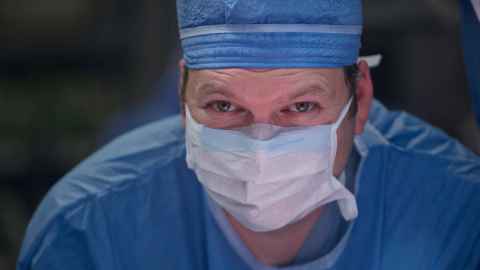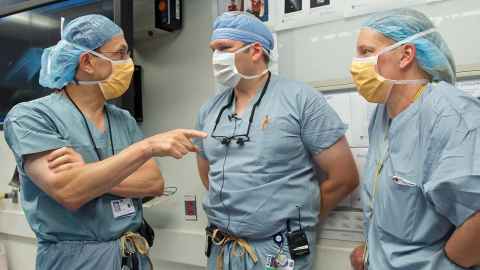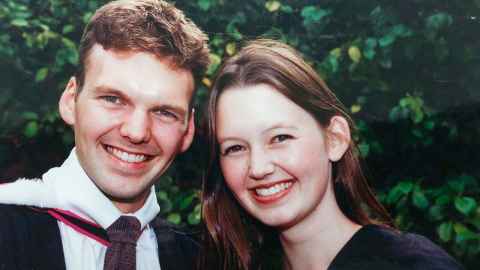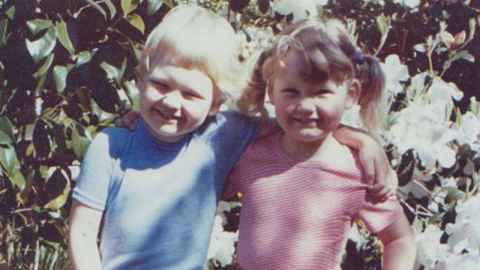Simon Talbot: out on a limb
31 May 2019
Top reconstructive surgeon Dr Simon Talbot is redefining what's possible in the world of transplants.

Each time Simon Talbot walks through the doors of his Boston hospital, he is faced with a challenge like no other.
The University of Auckland alumnus was a recent recipient of one of the four 2019 Distinguished Alumni Awards and as a world-leading reconstructive plastic surgeon at Brigham and Women's Hospital (BWH), he performs surgical feats often deemed impossible, or never seen before.
Simon first made headlines across the world after successfully leading teams undertaking ground-breaking double-arm transplants in 2011, 2014 and 2016.
He is the director of the Upper Extremity Transplant Programme at BWH, where he specialises in arm and hand transplants. He has also been involved with seven face transplants. What he's learned along the way has helped in related operations, including one in which a patient's nose and upper lip had to be reattached after being bitten off and swallowed by a pit bull terrier.
It sounds like sci-fi, but finding creative solutions to unprecedented problems is part of the job – even if that requires reattaching part of someone's face after it has been in a dog's stomach.

"When you're neck-deep in the kinds of things we do, it's hard to know what's considered totally left-field," Simon says. "I work in an area where we are confronted with unique situations every day. Successful patient outcomes depend on lateral thinking and creativity."
In the instance of the dog attack, he and his colleagues weren't aware of other cases of swallowed tissue being retrieved from an animal's stomach. Although the situation was unusual, they decided the best option was to get it out.
"A patient's own tissue is unique in terms of contours, structure and function. There is no perfect replacement for facial tissues anywhere else in the body."
The time from the dog attack to surgery took around six hours. Three teams were involved and several operations were required for the desired result.
We joined up the blood vessels, let off the clamps and blood flowed into the patient's hand. We saw that hand become a part of the patient.
Simon was also part of a team of 13 surgeons who performed a double-arm transplant at BWH in 2011. The recipient was 65-year-old Richard Mangino, who had lost all four limbs after a severe infection as the result of a kidney stone.
News of the operation was broadcast internationally and its progress was tracked on the BWH YouTube channel. This was followed by another double-arm transplant, in 2014, involving a patient who had lost all limbs to a streptococcal infection. In 2016, a third case caught the attention of the media worldwide, after Simon and his team performed a double-arm transplant on a retired Marine who had become a quadruple amputee after stepping on an explosive device in Afghanistan.
Simon, 42, is an associate professor at Harvard Medical School. As well as taking care of patients and teaching students, Simon also leads a research laboratory with funding from the United States Department of Defence. He collaborates with groups to innovate plastic surgical practices using engineering technology in microsurgery and nerve regeneration.
He says the process of transplanting arms and hands is a huge undertaking for everyone involved. The patient has to pass a number of psychological and physiological assessments, a suitable donor must be found and around 40 people are involved with the surgery itself, which can take up to 24 hours.
That's just the beginning for the patient, who will then commit to a long-term rehabilitation programme and take immunosuppressive medication for the rest of their life. In most cases, the patient is able to perform daily tasks that were once impossible and also feels more confident with their appearance.
"I get the opportunity to take care of patients who are going through a terrible time and I have the privilege of making a huge difference in people's lives.
"I know it sounds cheesy, but that's truly what gets me up each day – and it gives you the meaning and satisfaction to keep going."
Following the 2013 Boston Marathon bombings, Simon and his colleagues were able to dramatically reduce the need for amputations because they were already well practised in attaching and reattaching limbs. When the first of the two bombs exploded, Simon and other surgeons rushed to help in the emergency room.
"The lesson that came from that is when you put a team of people together, you really can achieve some amazing feats.
"We were able to save a lot of limbs and help a tremendous number of people by working as a team."

Growing up with a cardiologist for a father and a nurse for a mother, Simon says dinnertime conversations could range from beta blockers to blood-pressure control, so he seemed destined for a medical career.
As a child, he was captivated by science and was fascinated with fixing things around the family's Hamilton home. His twin sister, Sarah Wallace, became a pathologist and Simon married Elizabeth Morgan, also a pathologist. In the early years of his career, Simon was fortunate to be mentored by the late Joseph E. Murray, who worked at the same hospital in which Simon works today. Dr Murray was awarded a Nobel Prize in Physiology in 1990 for his pioneering efforts in the field of transplant surgery.

Dr Murray not only passed on his medical knowledge, but also philosophical views that Simon holds in high regard.
"He used to say 'every challenge is an opportunity', and that's something that I try I live by. It really exemplifies how I think we should handle the seemingly impossible."
The most memorable surgery for Simon was the first time he and his colleagues transplanted a limb at BWH.
"We joined up the blood vessels, let off the clamps and blood flowed into the patient's hand. We saw that hand become part of the patient. That, for me, is the culmination of years and years of training and hard work to create an incredibly memorable and special moment." Simon says improving his patients' quality of life is extremely fulfilling.
"You should always want to leave the world a better place than when you arrived, and fundamentally that's what I'd like to do with my career."
In the little spare time he has, Simon volunteers at hospitals in developing countries, but also enjoys baking and putting his green thumb to good use.
"Right now, a particular hobby is regenerating and replanting a small native forest in the northeast, so I'm working to get better at forestry." Simon has always loved getting amongst nature. He says during his university days, he and some friends went adventuring in a forest and were close to never seeing his mum's car again, after nearly losing it on a forestry road.
"We saved the car but it was never the same." Living amid the hustle and bustle of Boston, he often yearns for New Zealand's outdoors. "I miss a lot of things about New Zealand. I miss a lot of my friends who live there and I miss the outdoor lifestyle; I think that is unmatched anywhere in the world."
Simon travelled back to Auckland in October 2018 for the Faculty of Medical and Health Sciences' 50th reunion and again in March for the University's 2019 Distinguished Alumni Awards.
"I take any invitation I can get to come back to New Zealand and it was an honour to be recognised as one of the Distinguished Alumni. I wouldn't be anywhere near where I am if it wasn't for the teaching I had at the University and the passion and encouragement I received." He visits his family in Aotearoa about once a year, and says the lengthy plane journey is always interesting.
"Whenever I'm on a plane and people find out I'm a reconstructive plastic surgeon, they start pulling on their face and asking what I think they should have done... there really is no good answer to that question."
By Briar Hubbard